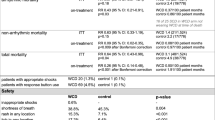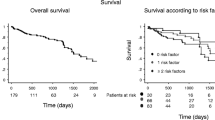Abstract
At first sight, guidelines for implantation of an implantable cardioverter defibrillator (ICD) for primary prevention of sudden cardiac death in patients with left ventricular systolic dysfunction seem unambiguous. There are clear cut-off values for ejection fraction, and functional class. However, determination of the ejection fraction itself is not unambiguous, and other risk factors for sudden death that may have a profound effect on risk are not used for decision-making. Furthermore, to obtain a clinically significant impact on survival, expected longevity is important as it can greatly compromise the benefit in elderly patients but underestimate the long-term potential of ICD therapy in younger patients. (Neth Heart J 2009; 17:107–10.)
Similar content being viewed by others
References
Epstein AE, Dimarco JP, Ellenbogen KA, et al. ACC/AHA/HRS 2008 Guidelines for Device-Based Therapy of Cardiac Rhythm Abnormalities: Executive Summary. A Report of the American College of Cardiology/American Heart Association Task Force on Practice Guidelines. Circulation 2008;52:1122–7.
van Erven L, van Dessel PFHM, Simmers TA, van Gelder IC, Haurer RNW, Wever EFD. Guidelines ICD implantation 2005 - an update, www.cardiologie.n1/2/pagecontent.
Zipes DP, Camm AJ, Borggrefe M, et al. ACC/AHA/ESC 2006 guidelines for management of patients with ventricular arrhythmias and the prevention of sudden cardiac death-executive summary: A report of the American College of Cardiology/American Heart Association Task Force and the European Society of Cardiology Committee for Practice Guidelines. Eur Heart J 2006;27:2099–140.
Tung R, Zimetbaum P, Josephson ME. A critical appraisal of implantable cardioverter-defibrillator therapy for the prevention of sudden cardiac death. J Am Coll Cardiol 2008;52:1111–21.
Bardy GH, Lee KL, Mark DB, et al. Amiodarone or an implantable cardioverter-defibrillator for congestive heart failure. N Engl J Med 2005;352:225–37.
Moss AJ, Zareba W, Hall WJ, et al. Prophylactic implantation of a defibrillator in patients with myocardial infarction and reduced ejection fraction. N Engl J Med 2002;346:877–83.
Yap YG, Duong T, Bland JM, et al. Optimising the dichotomy limit for left ventricular ejection fraction in selecting patients for defibrillator therapy after myocardial infarction. Heart 2007;93:832–6.
Curtis JP, Sokol SI, Wang Y, et al. The association of left ventricular ejection fraction, mortality, and cause of death in stable outpatients with heart failure. J Am Coll Cardiol 2003;42:736–42.
Otterstad JE, Froeland G, St John Sutton M, Holme I. Accuracy and reproducibility of biplane two-dimensional echocardiographic measurements of left ventricular dimensions and function. Eur Heart J 1997;18:507–13.
Hare JL, Brown JK, Marwick TH. Performance of conventional echocardiographic parameters and myocardial measurements in the sequential evaluation of left ventricular function. Am J Cardiol 2008;101:706–11.
Buxton AE, Lee KL, Hafley GE, et al. Limitations of ejection fraction for prediction of sudden death risk in patients with coronary artery disease: lessons from the MUSTT study. J Am Coll Cardiol 2007;50:1150–7.
Solomon SD, Zelenkofske S, McMurray JJ, et al. Sudden death in patients with myocardial infarction and left ventricular dysfunction, heart failure, or both. New Engl J Med 2005;352:2581–8.
Buxton AE. Sudden death after myocardial infarction—who needs prophylaxis, and when? N Engl J Med 2005;352:2638–40.
Ottervanger JP, Ramdat Misier AR, Dambrink JH, et al. Mortality in patients with left ventricular ejection fraction </=30% after primary percutaneous coronary intervention for ST-elevatlon myocardial infarction. Am J Cardiol 2007;100:793–7.
Pascale P, Taffe P, Regamey C, Kappenberger L, Fromer M. Reduced ejection fraction after myocardial infarction: is it sufficient to justify implantation of a defibrillator? Chest 2005;128:2626–32.
Goldenberg I, Vyas AK, Hall WJ, et al. Risk stratification for primary implantation of a cardioverter-defibrillator in patients with ischemic left ventricular dysfunction. J Am Coll Cardiol 2008;51:288–96.
Cuculich PS, Sánchez JM, Kerzner R, et al. Poor prognosis for patients with chronic kidney disease despite ICD therapy for the primary prevention of sudden death. PACE 2007;30:207–13.
Costea A, Rardon DP, Padanilam BJ, Fogel RI, Prystowsky EN. Complications associated with generator replacement in response to device advisories. J Cardiovasc Electrophysiol 2008;19:266–9.
Gould PA, Krahn AD. Complications associated with implantable cardioverter-defibrillator replacement in response to device advisories. JAMA 2006;295:1907–11.
Kleemann T, Becker T, Doenges K, et al. Annual rate of transvenous defibrillation lead defects in implantable cardioverter-defibrillators over a period of >10 years. Circulation 2007;115:2474–80.
Sola CL, Bostwick JM. Implantable cardioverter-defibrillators, induced anxiety, and quality of life. Mayo Clin Proc 2005;80:232–7.
Thomas SA, Friedmann E, Kao CW, et al. Quality of life and psychological status of patients with implantable cardioverter defibrillators. Am J Crit Care 2006;15:389–98.
Sweeney MO, Wathen MS, Volosin K, et al. Appropriate and inappropriate ventricular therapies, quality of life, and mortality among primary and secondary prevention implantable cardioverter defibrillator patients: results from the Pacing Fast VT REduces Shock ThErapies (PainFREE Rx II) trial. Circulation 2005;111:2898–905.
Daubert JP, Zareba W, Cannom DS, et al. Inappropriate implantable cardioverter-defibrillator shocks in MAD IT II: frequency, mechanisms, predictors, and survival impact. J Am Coll Cardiol 2008;51:1357–65.
Maron BJ, Spirito P, Shen WK, et al. Implantable cardioverter-defibrillators and prevention of sudden cardiac death in hypertrophic cardiomyopathy. JAMA 2007;298:405–12.
Korte T, Köditz H, Niehaus M, Paul T, Tebbenjohanns J. High incidence of appropriate and inappropriate ICD therapies in children and adolescents with implantable cardioverter defibrillator. PACE 2004;27:924–32.
Mark DB, Nelson CL, Anstrom KJ, et al. Cost-effectiveness of defibrillator therapy or amiodarone in chronic stable heart failure: results from the Sudden Cardiac Death in Heart Failure Trial (SCD-HeFT). Circulation 2006;114:135–42.
Zwanziger J, Hall WJ, Dick AW, et al. The cost effectiveness of implantable cardioverter-defibrillators: results from the Multi-center Automatic Defibrillator Implantation Trial (MADIT)-II. J Am Coll Cardiol 2006;47:2310–8.
Healey JS, Hallstrom AP, Kuck KH, et al. Role of the implantable defibrillator among elderly patients with a history of life-threatening ventricular arrhythmias. Eur Heart J 2007;28:1746–9.
Grimm W. Outcomes of elderly heart failure recipients of ICD and CRT. Int J Cardiol 2008;125:154–60.
Ellenbogen KA, Levine JH, Berger RD, et al. Are implantable cardioverter defibrillator shocks a surrogate for sudden cardiac death in patients with nonischemic cardiomyopathy? Circulation 2006;113:776–82.
Borleffs CJ, Wilde AA, Cramer MJ, Wever E, Mosterd A. Clinical implementation of guidelines for cardioverter defibrillator implantation: lost in translation? Neth Heart J 2007;15:129–32.
Siu LL. Clinical trials in the elderly-a concept comes of age. New Engl J Med 2007;356:1575–6.
Bokhari F, Newman D, Greene M, Korley V, Mangat I, Dorian P. Long-term comparison of the implantable cardioverter defibrillator versus amiodarone: eleven-year follow-up of a subset of patients in the Canadian Implantable Defibrillator Study (CIDS). Circulation 2004;110:112–6.
de Vreede-Swagemakers JJ, Gorgels AP, Dubois-Arbouw WI, et al. Out-of-hospital cardiac arrest in the 1990's: a population-based study in the Maastricht area on incidence, characteristics and survival. J Am Coll Cardiol 1997;30:1500–5.
Huikuri HV, Castellanos A, Myerburg RJ. Sudden death due to cardiac arrhythmias. N Engl J Med 2001;345:1473–82.
Josephson M, Rosen M, Tomaselh G. The year in arrhythmias-2007: Part I. Heart Rhythm 2008;5:742–8.
Myles RC, Jackson CE, Tsorlalis I, Petrie MC, McMurray JJ, Cobbe SM. Is microvolt T-wave alternans the answer to risk stratification in heart failure? Circulation 2007;116:2984–91.
Buxton AE, Hafley GE, Lehmann MH, et al. Prediction of sustained ventricular tachycardia inducible by programmed stimulation in patients with coronary artery disease. Utility of clinical variables. Circulation 1999;99:1843–50.
Dekker LR, Bezzina CR, Henriques JP, et al. Familial sudden death is an important risk factor for primary ventricular fibrillation: a case-control study in acute myocardial infarction patients. Circulation 2006;114:1140–5.
Arking DE, Chugh SS, Chakravarti A, Spooner PM. Genomics in sudden cardiac death. Circ Res 2004;94:712–23.
Author information
Authors and Affiliations
Corresponding author
Additional information
Department of Cardiology, Catharina Hospital, Eindhoven, the Netherlands
F. Bracke Department of Cardiology, Catharina Hospital, PO Box 1350, 5602 ZA Eindhoven, the Netherlands
Rights and permissions
About this article
Cite this article
Bracke, F.A.L.E., Dekker, L.R.C., van der Voort, P.H. et al. Primary prevention with the ICD in clinical practice: not as straightforward as the guidelines suggest?. NHJL 17, 107–110 (2009). https://doi.org/10.1007/BF03086228
Issue Date:
DOI: https://doi.org/10.1007/BF03086228




